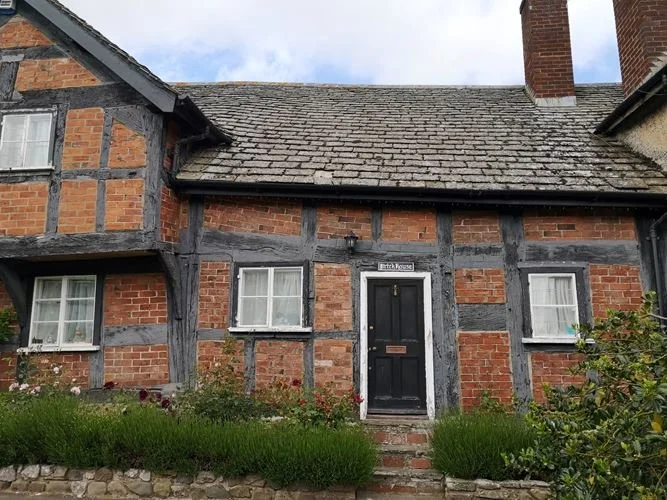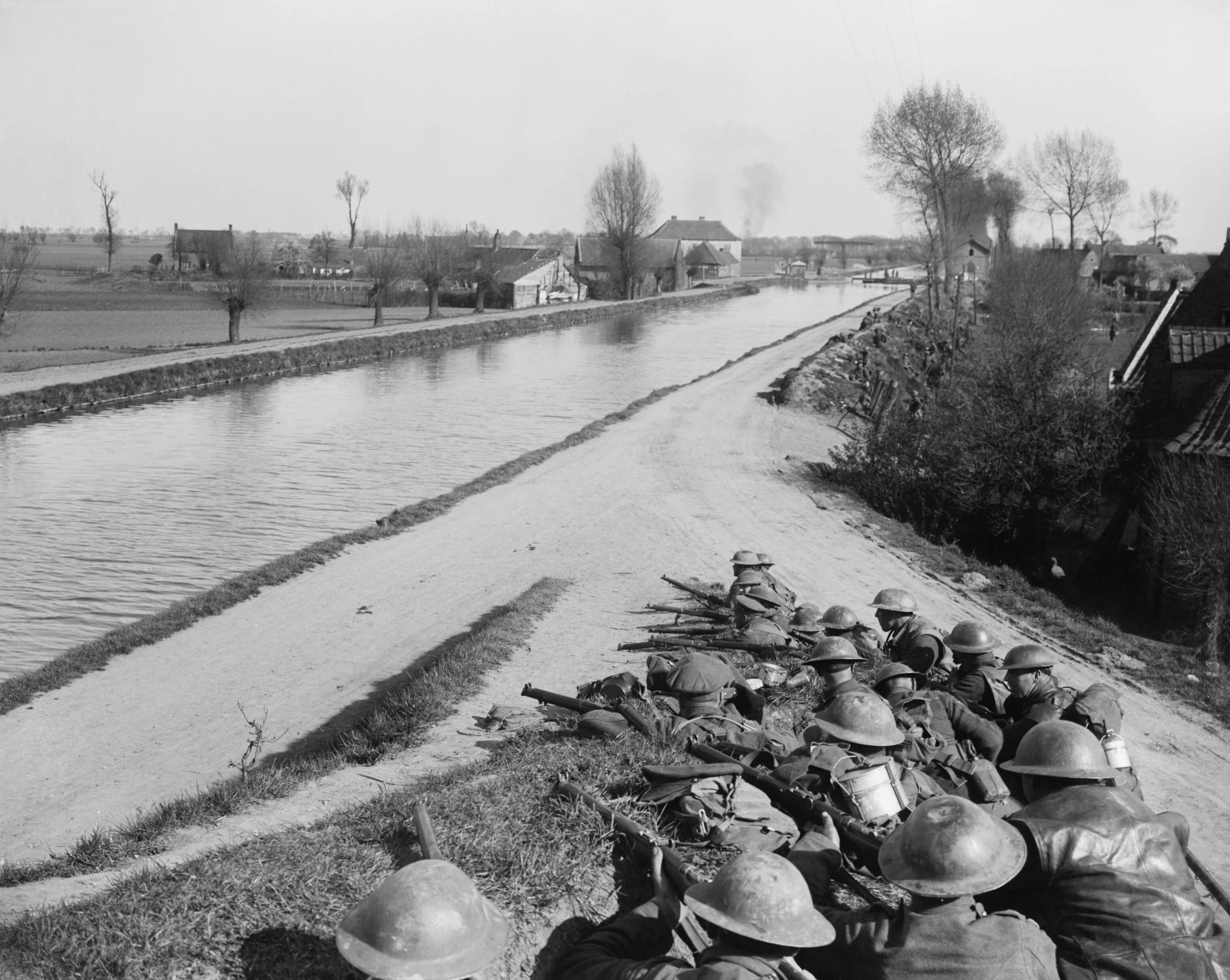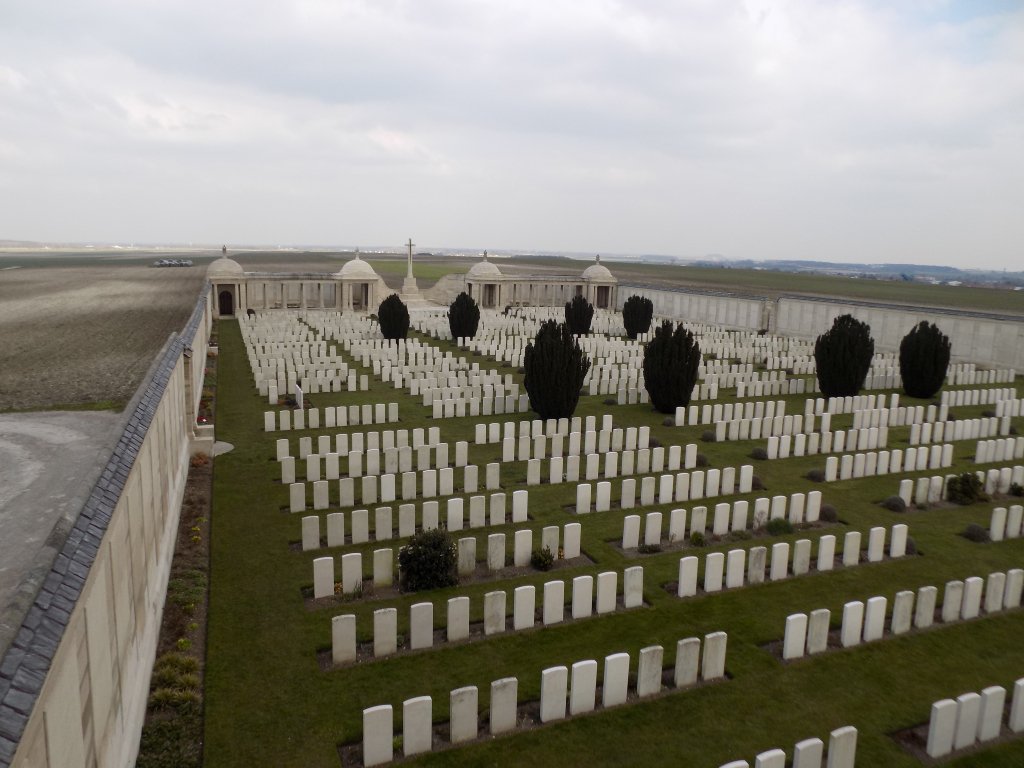George Eversham, Private, 8th Battalion Gloucestershire Regiment
In the 1901 census, George Eversham, aged 10, is living with an older brother, William, and an older sister, Rose, along with his mother Elizabeth and father George in what appears to be, according to the blurred handwriting in this census, Brick House Farm, West Street, Pembridge.
Above photo: Brick House, Pembridge, today (1)
George Eversham’s father is described as a cowman. The latter was born in Holm Lacy, Herefordshire while George Eversham’s mother was born in Clifford, Herefordshire. George, himself, had been born in Bredwardine, Herefordshire. There is also a 78-year-old widow, Elizabeth, residing at Brick House Farm. This woman is described as “deaf for the past twenty years”. Elizabeth was born in Peterchurch, Herefordshire. It is possible that Elizabeth might have been George’s grandmother on his mother’s side.
The 1911 census states that the family were still living in Pembridge with George’s father, now 51, still working as a “cowman on farm”. George Eversham (junior) is described as a “groom, gardener” at Westonbury, Pembridge.
According to the Hereford Times, George Eversham enlisted in The Herefordshire Regiment in May 1916.
As there were too few volunteers to fill the ranks, the Military Service Bill had been introduced in January 1916, with compulsory conscription for the first time in Britain's history. Every unmarried man and childless widower between 18 and 41 was offered three choices:
1/ Enlist at once.
2/ Attest at once under Derby's system.
3/ Or on 2 March 1916 be automatically deemed to have enlisted.
In May 1916 the bill was extended to married men.
It’s most likely that he found himself in either the 2nd or 3rd Battalion, Herefordshire Regiment.
Three months later on 27th August 1916, George had married Edith Oakley, the daughter of William Oakley, a gardener who, the 1911 census states, was residing in Upton Bishop.
Above photo: George Eversham’s father-in-law, William Oakley (2)
The date of this marriage will determine the date of George Eversham’s death as the records in regard to the latter differ.
“The 2nd Battalion was formed on 22nd August 1914 and at that time comprised the small Hereford Depot staff and the hundreds of volunteers that had enlisted. The battalion became an operational Battalion allocated to UK Home Defence. It never served overseas.
The 3rd/1st Battalion was formed in Autumn 1914 - again to handle the large number of volunteers. It became the Depot & Training Battalion for the Regiment, training new recruits and receiving soldiers returning to fitness after wounds and sickness before posting them to an operational unit.” (3)
As things settled down many of these men were transferred as reinforcements to the 1st Battalion and other operational units. (4)
George Eversham was transferred to the 8th Battalion, Gloucestershire Regiment.
He most likely would not have gone to The Western Front until 1917. During that year, the 8th Battalion saw action in June during the Battle of Messines Ridge (7th-14th June)
“Messines Ridge, located south of Ypres, was captured by German forces in 1914. The ridge granted the German Army a dominant position overlooking the Ypres salient.
After years of suffering heavy casualties in the salient in 1917, the Allies planned to break out. The first move was to capture the Messines Ridge. Taking the ridge would leave the Allies better placed to launch their offensive to the north-east -toward Passchendaele.
General Sir Herbert Plumer planned the attack at Messines in meticulous detail. His forces also underwent thorough training to ensure the artillery and infantry worked together effectively.” (IWM)
“Tunneling work beneath the Messines Ridge began in 1916. At zero hour - 3.10am on 7 June – 19 mines were detonated beneath the German positions in an explosion that could be heard in London. Thousands of German defenders were killed or wounded and many more were psychologically shaken.
Above photo: British troops stand looking at the huge mine crater (Messines Ridge) blown up on the morning of the battle (IWM)
Like all aspects of the attack at Messines, the artillery support was carefully planned and coordinated. During the preliminary bombardment, air reconnaissance reported on German battery positions so they could be targeted by Allied guns.
A creeping barrage accompanied the advancing infantry during the attack, while a lifting barrage hit German positions further ahead, lifting and moving further back once the attack came within a certain distance.
Plumer's force of New Zealand, Irish, Australian, Canadian and British troops took their objectives within a matter of hours and 7,000 German soldiers were captured. German counterattacks failed to retake the territory they had lost.
Plumer built on the lessons of the Somme and Arras to combine artillery, mines, air power, infantry and tanks in a carefully planned and ultimately successful attack.” (IWM)
Above photo: Advanced Dressing Table at Messines (5)
The 8th Battalion, Gloucestershire Regiment, fought two minor actions in July near Oosttaverne, south of Ypres, and was then involved in the Battle of Menin Road Ridge in September (1917).
“The Battle of the Menin Road Ridge marked the renewal of the Third Battle of Ypres. A period of poor weather in August had caused a hiatus in the offensive, but following better weather in September the British Army was able to re-launch the attack with an assault on the German positions on the vital high ground of the Gheluvelt Plateau astride the Ypres-Menin Road.
Command of the offensive had passed to General Herbert Plumer, commander of Second Army, which included two Anzac Corps formed of Australian and New Zealand units.
At the start of the battle, British artillery unleashed an incredibly concentrated bombardment – there was one gun for every five yards of ground. Objectives for the attack were limited to within 1,500 yd, well within range of the British artillery.
Known as ‘bite and hold’, the plan was for British Empire troops to attack under the cover of a heavy artillery bombard, take a bite out of a section of German defences and then quickly prepare the captured position to hold it against the inevitable German counter-attack.” (CWGC)
Above photo: A 6 Inch 26 CWT Mark I Howitzer. One of a battery which participated in the Third Battle of Ypres (AWM)
“The attack was largely successful despite strong German defences including concrete block houses and fierce German counter-attacks.
Some of the severest fighting took place in the south around an area known as ‘Tower Hamlets’, just west of Gheluvelt village. Despite repeated attacks by the British, German troops were still in control of the area by nightfall.
Despite obtaining most of their objectives, the battle still proved costly for the British Army. The British Official History places British casualties for 20–25 September 1917 at 20,255 wounded, killed or missing.” (CWGC)
Above photo: German prisoners captured during The Battle of Menin Road, 1917 (NAM)
“The battalion was next in action on the evening of 21 March 1918, the first day of the German Spring Offensive, when the Germans captured Doignies. Unable to recapture the village, the battalion blocked any further enemy progress until the morning of 23rd March, when German forces broke through on the left and threatened to outflank it. Company A fought to the last man covering the battalion's withdrawal, for which action the company commander, Captain Manley Angell James, was awarded the VC. By the time the 19th Division withdrew to Doullens on 28 March the battalion had suffered 323 casualties. In April, the battalion fought in three engagements of the Battle of the Lys: the Battles of Messines, Bailleul and First Kemmel.” (Wikipedia)
Above photo: Battle of The River Lys (Wikipedia)
The date of George Eversham’s death differs according to the records.
The Commonwealth War Graves Commission states that George Eversham died on 17th April 1916.
The Imperial War Museum tells us that George Eversham died on 17th April 1917
The two service numbers referring to George Eversham in both The Imperial War Museum and The Commonwealth War Graves Commission records are the same yet the IWM states that he died exactly one year later than The Commonwealth War Graves Commission states.
Another register “Soldiers Died in The Great War” supports the 17th April 1917 date.
To add to the confusion, “The UK British Army Register of Soldiers Effects” tells us that George Eversham died on 17th April 1918 leaving the sum of £4 2s 5d (back pay) to his wife, Edith - his service number 260382 matching the service numbers in the other three above mentioned records.
Further there is the following -
“WW1 Joint Organisation Enquiries: Missing, Wounded and Dead Personel 1914-1918 - -
Name, George Eversham
Birth Place, Bredwardine, Herefordshire
Death Date, 17 Apr 1918
Death Place, France and Flanders
Enlistment Place, Leominster
Rank, Private, Gloucestershire Regiment
Battalion, 8th Service Battalion
Regimental Number, 260382
Type of Casualty, Killed in action
Theatre of War, Western European Theatre
Comments. Formerly 5254, Herefordshire Regiment.”
This record matches “The UK British Army Register of Soldiers Effects”record.
So, what does one make of it? I am inclined to believe that the “UK Army Register of Soldiers Effects” and the “WW1 Joint Organisation Enquiries: Missing, Wounded and Dead Personel 1914-1918” have the correct date - 17th April 1918. In the former, it specifically states that he left £4 2s 5d to his widow Edith (nee Oakley).
Therefore, given that he did not marry Edith until August 1916, the CWGC Registry is most certainly wrong as the records show show that George Eversham had married Edith four months after his stated CWGC date of death.
That leaves the IWM date, 17th April 1917, unanswered. Given that the “UK Army Register of Soldiers Effects” specifically states in handwriting that he left the above mentioned legacy to his widow Edith and in that same document, it states George Eversham’s date of death as 17th April 1918, it is reasonable to think that the IWM date of death is also incorrect. Also, to give further credibility to the 17th April 1918 date of death of George Everhsam, the Commonwealth War Graves Commission states the following about the Dud Corner Loos Memorial where he is commemorated -
“The Dud Corner Loos Memorial commemorates over 20,000 officers and men who have no known grave, who fell in the area from the River Lys to the old southern boundary of the First Army, east and west of Grenay, from the first day of the Battle of Loos to the end of the war.” (CWGC)
Above photo; Dud Corner Loos Memorial (CWGC)
Given where George Eversham is buried, it would suggest that George Eversham was killed in action at one of the previously mentioned battles that took place in April 1918 – The Battle of Lys, Messines, Bailleul or First Kemmel – the most likely being the Battle of The River Lys.
“The Dud Corner Loos Memorial forms the sides and back of Dud Corner Cemetery. The name "Dud Corner" is believed to be due to the large number of unexploded enemy shells found in the neighbourhood after the Armistice.
Above photo; The Dud Corner Loos Memorial (CWGC)
Above photo: Edith Oakley (Edith Eversham) and Annie (Edith’s sister), place and date unknown although paper header seems to refer to woman and arms work, so maybe 1939/45? (6)
Rory MacColl
Sources
1/ https://historicengland.org.uk/listing/the-list/list-entry/1081732
2/ https://www.ancestry.co.uk/family-tree/person/tree/75169633/person/36311289553/facts
3/ https://herefordshirelightinfantrymuseum.com/wars/wwi/
4/ https://herefordshirelightinfantrymuseum.com/wars/wwi/
5/ https://natlib.govt.nz/records/22324292
6/ https://www.ancestry.co.uk/family-tree/person/tree/75169633/person/36311292380/facts











